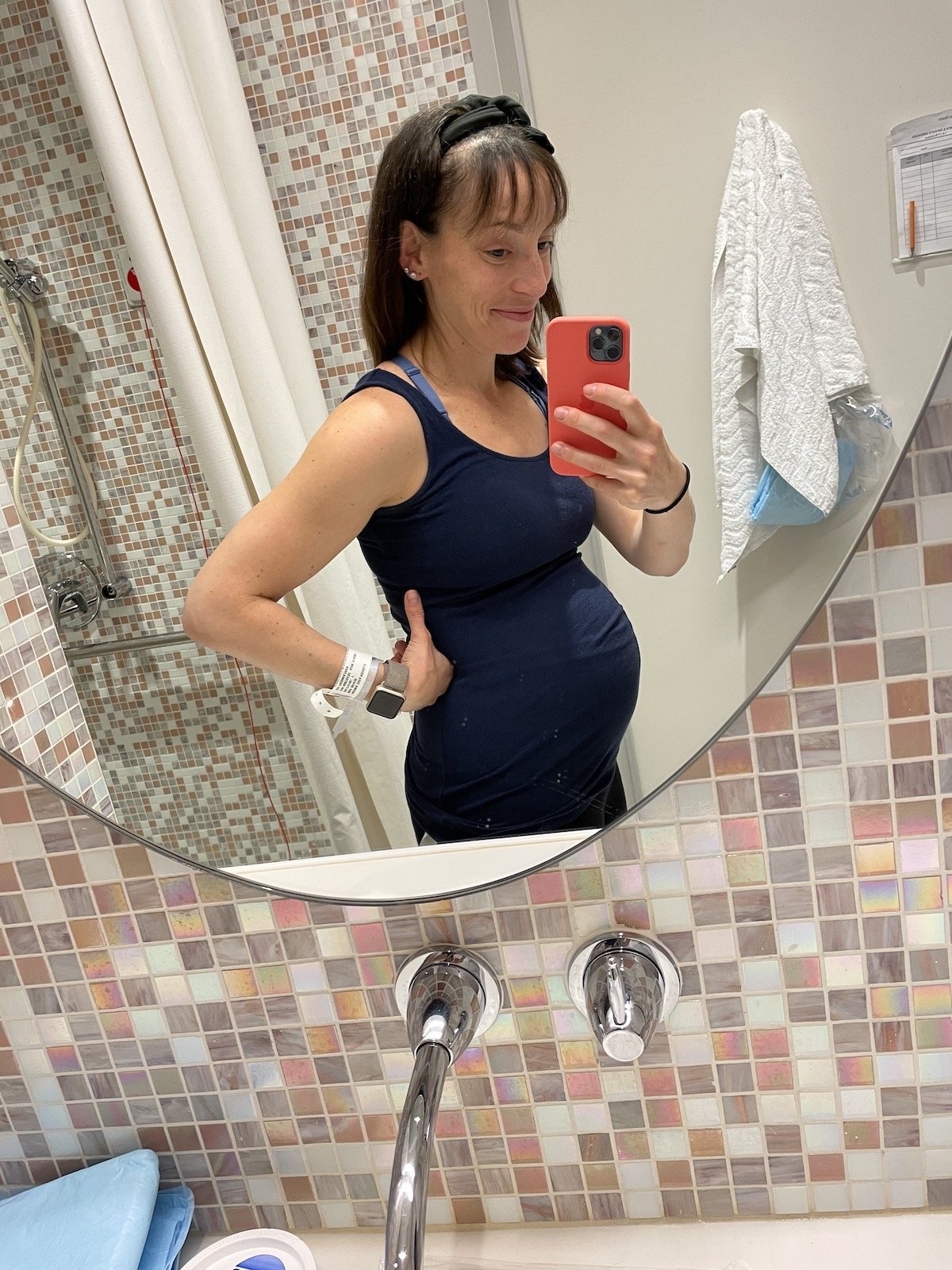Postpartum Sh*t No One Talks About
After having my first son I felt overwhelmed. I knew becoming a mother would be a big transition, but I felt completely unprepared for the first few months. Of course there was extreme exhaustion and lots of poopy diapers, but what I did not expect was my postpartum body. I looked in the mirror and didn't recognize myself. I felt disconnected from my my lower half and everything just felt "different." Yet, all of the moms across social media and on TV seemed to have their sh*t together (or so I thought). How?!
I was "cleared" at my 6-week check up by my OB/GYN and sent on my way. But, when I hopped on a treadmill for the first time I felt like my insides were going to fall out. I felt unsupported, vulnerable, and unprepared to head back to the gym. "Why didn't anyone tell me it would be like this?" I thought over and over.
I was blindsided by the postpartum process and what my body had become. I felt lost and unsure of how to safely progress back to exercise and heal without hurting myself. This is why I sought additional education. I wanted to empower and educate myself and other moms about the changes that occur during pregnancy and postpartum, as well as safe and intentional ways to train and heal. I share my experience across social media so that other moms know they are NOT alone.This week on social media I've been talking about sh*t no one talks about postpartum. While there are LOTS of different things I can address, below are just a few postpartum challenges.
Mom Butt
Many moms talk about losing their butt after having kids. I promise - your butt is still there! During pregnancy as the belly grows, we find stability by gripping our glutes. Once the baby joins the party and our core is compromised - the gripping continues. The constant glute gripping not only creates a flat booty appearance, but it’s not so great for our pelvic floor either. Over time living in this position, some muscles in our body (like hip flexors) start to get tight, while others (like glutes and spine stabilizers) get weak
1. Stop Clenching: We need to ditch the gripping. How do you do this? Grip your butt super tight and then relax it. Try again. Sometimes we don’t even realize we are doing it throughout the day. So, schedule in “butt checks,” especially when holding baby, lifting something, doing dishes, etc. Are you gripping? Let it go!
Here’s a fun trick: Imagine there is a piece of string attached to the top of your butt, with something gently pulling it upward. We want a slight natural curve in the low back, without the pelvis pushing forward. This will keep us in a neutral position. Becoming aware of where our body likes to live in space makes a big difference.
2. Release: get that foam roller out because those hip flexors/quads need some TLC. I also recommend a kneeling hip flexor stretch.
3. Breathe: In order to reestablish IAP (intra-abdominal pressure) after having a baby, we need to relearn how to breathe. I like using the 90/90 with a block squeeze for some internal rotation/adductor activation. This helps allow us to fully access the glute max. A lot of moms live in external rotation (waddle) during pregnancy.
4. Strengthen: Postpartum is A LOT of glute / core training - the perfect combo to defeat mom butt! My baseline go-go’s are hip thrusts, glute bridges, hinge variations, and squat variations (box/goblet). These exercises need to be mastered before adding more load / challenge. We need to relearn how to fully lengthen the glutes in order to strengthen.
Pelvic Floor Physical Therapy
It's unfortunate I have to list Pelvic Floor Physical Therapy as something no one talks about! Pelvic Floor Physical Therapy has changed my life in many ways. For starters, I've become far more AWARE of my body and how it functions, the power of breath, and why a PT referral SHOULD be standard of care. I talk to so many womxn who are not given a referral, have never heard of a Pelvic Floor PT, or have had their symptoms normalized by another practitioner, their partner, friends, social media, etc.
It's not NORMAL to:- Leak pee or poop after having kids-Experience pain of any kind in the pelvis or vagina (or really anywhere)-Have painful sex-Fear picking up your kids, being intimate with your partner, or performing daily tasks of motherhood / life.Having a baby is a big deal. We deserve the right to care to recover, and feel like our best selves. This includes physically AND emotionally. Pelvic Organ Prolapse, Diastasis Recti, Hernia, birth in general, etc. - all of these are as much an emotional experience as a physical one. They require a full body healing approach. I currently have diastasis recti and have had hernia repair and pelvic floor dysfunction in the past. I've felt broken, ignored, and frustrated. Being told this was "how it was" not only angered me, but made me feel lost in my new body (which didn't help my postpartum mental health).If you are told kegels are the ONLY way or that doing crunches are going to give you a flat belly - I encourage you to find another coach or physician.It doesn't matter if you had kiddos five days ago, five years, five decades, etc. Your symptoms and experience do not need to be normalized as something that "just happens" during motherhood, or just deemed "not that bad." Like any injury, there is someone that can support you.
Your Bras Don't Fit
Bra too tight? Yea - me too.And guess what - this may have NOTHING to do with cup size or weight. During pregnancy the uterus expands / baby grows right underneath your rib cage. The ribs are pushed up and out to make room - kind of like being stuck in a big inhale. After baby arrives, our rib cage is stuck in a flared out position. You may have heard of “rib flare,” but there are really two parts to this:
1. Rib positioning: this is when your posture affects the positioning of your rib cage. Move your pelvis forward and back. Clench your butt. Round your shoulders. Experiment. If you’re in more of anterior pelvic tilt (booty popping, chest up) notice where your rib cage likes to hang. Switch to tucking under, pelvis shifted forward. Do you notice how both positions shift your rib cage position? There’s no “perfect” posture, but being more “neutral” (ribs over pelvis) helps the body function function optimally (pelvic floor / diaphragm can interact). Keep moving - the best posture is your next posture. So keep it fluid.
2. Rib angle(infrasternal angle): This can be fun to experiment with by taking a washable marker and feeling for the sides of your rib cage. When the angle is wider than 90 degrees (like during and after pregnancy) it places a lot of tension on the anterior (front) abdominal wall. To help address we have to change how the muscles work and fire. Wider than 90 degrees and it’s like we are stuck in a big inhale. We need to get those ribs down and in to help with more efficient respiration, Diastasis healing, pelvic floor function (pelvic floor tightness can promote state of inhalation too), etc. You may notice tension in your back if this is the case. Someone has to pick up the slack for what’s going on in the front. As we return back to fitness, rib cage angle is something to think about because it also gives us clues as to how our body is functioning, how you’re breathing, and which accessory muscles may be jumping in. We want to get ribs down, core connected, and THEN we load.
Want to learn more about rib flare? Check out this post.
"Bouncing back" doesn't happen overnight...or maybe ever
Bounce back culture is very real. As a new mom I felt overwhelmed by the images of #fitmoms on Instagram who seem to be doing it all: sleeping, having time to make delicious avocado toast / beautiful foodie creations, and fit into their pre-pregnancy jeans, all with a smile and perfectly done hair. How?!
Before my first and second pregnancies I did a lot of self work to develop a better body image. I felt at peace with my body, nutrition, and exercise regime. But during pregnancy and postpartum I felt a bit lost once again, and struggled (still do) to embrace my new body. Turns out, I'm not alone. Research shows body dissatisfaction during and after pregnancy is a top concern for many womxn, yet there aren't too many resources or support to help us navigate this time. We have some work to do.
I like to remind myself (and other mamas) - you just grew a human! Your body was stretched, your organs were moved around, postpartum hormones are all over the place, and you're trying to keep another human alive. Although society sometimes paints a very different picture, you cannot birth a human and then instantly bounce back. We can absolutely rehab the body and get functional and strong again. But, our hips may be wider, breasts may be smaller or larger, and we may have stretch marks, new moles, and loose skin.
Expecting to look like your favorite movie star after birth isn't realistic or healthy. I will also add these womxn also often have lots of photoshop, a make up artist, nutritionist, makeup artist, night nurse, nannies, Personal trainer / Coach, Physical Therapist (I hope), massage therapist, etc. I don't know too many womxn that have all of those resources! Focus on healing, function, sleep, eating nourishing foods, and the rest will follow. Also - check out these tips for avoiding postpartum comparisons. There is a ton of sh*t people don't talk about postpartum. I hope to dive into more of these topics in the coming weeks.
You don't always lose weight while breastfeeding
Postpartum Hormones
Constipation / Postpartum pooping
Postpartum hairloss
Your may need to go up in shoe size
The 6-week check up doesn't cover everything and isn't your official "GO TIME" (Check out this post - Pelvic Floor PT vs. OB/GYN 6-Week Check)
Are there things you wish you had been told about postpartum recovery, body image, training, etc.? Let me know below :) If you’re early postpartum and looking for some free guidance on returning to movement, check out my FREE early postpartum resource.
Feel good mama! And remember - I got your back.
xoxo,
Erica


